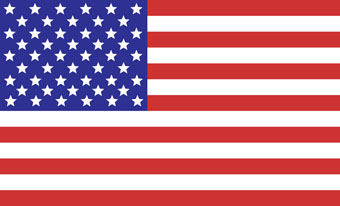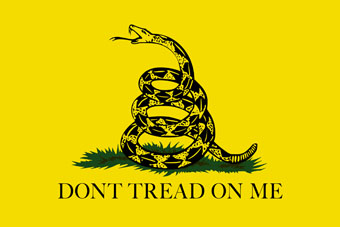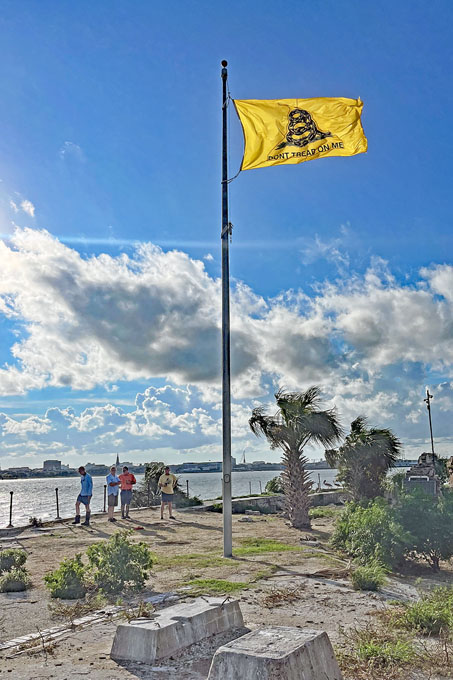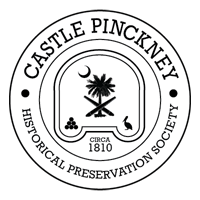
Hibernian Society Member Raises Gadsden Flag at Castle Pinckney
Aug. 24, 2025
Imagine carrying a large flag, boarding a small boat and traveling to a small island in the center of Charleston Harbor. Then imagine disembarking at the island, and walking across a marsh to an abandoned 215-year-old fort.
Your mission is to unlock the fort’s front entrance, enter and walk to the top of the fort to conduct a flag raising ceremony.
Castle Guardians, loyal volunteers, regularly do this. John Mahoney, one such Guardian, led members of the Hibernians Society of Charleston to Castle Pinckney at 6 p.m. on Sunday, August 24 to conduct the latest flag ceremony – to lower one flag and raise a new one atop the tall flag pole erected inside the fort.


“We picked a break in our tropical weather to lower the U.S. Flag, ‘Old Glory,’ which had flown over Castle Pinckney since July 3, and to replace it with a relatively new Gadsden Flag,” said Mahoney. “Our choice was a bit random, but the Gadsden Flag is always a crowd pleaser.”
Joseph McInerney, Jr., Past President of the Hibernian Society of Charleston, and his son, Joseph III, transported the small group across the harbor to Castle Pinckney at about 5:30 p.m. and arrived at the site about 30 minutes later. The group departed the island around 7 p.m. and returned home about 45 minutes later.

“Tides and ship traffic in the harbor weren’t optimal,” Mahoney said, “so we managed a celebratory ‘long way back’ to the dock.”
Mahoney had previously visited Castle Pinckney on July 3 to raise Old Glory to commemorate Independence Day (July 4, 1776). After what he described as “a flurry of expected commemorations over a one week period,” including Carolina Day (June 28, 1777), Mahoney said he then let Old Glory remain fly over Cast Pinckney until the Hibernian Society group recently replaced it with the Gadsden Flag.”
The decision to raise the Gadsden Flag was an easy one.
“The Gadsden Flag has so much meaning,” Mahoney explained. “The period in which the flag originally flew is very close in sync with our jewel, Castle Pinckney, that protected Charleston while our fledgling new Republic continued to struggle for its independence. The flag, an amazing graphic, illustrates how totalitarian regimes ‘divide and conquer.’”
Castle Pinckney was constructed around 1810 on Shute’s Folly, a small island in Charleston Harbor, to defend the city against the British prior to the War of 1812.
“My friend, Christopher Gadsden, a member of the Hibernian Society and a descendant of Christopher Gadsden for whom the flag is named,” Mahoney said, “was given the honor of unfurling and hoisting the flag.”
The yellow flag, which depicts a timber rattlesnake coiled and ready to strike above the words, “Dont Tread on Me,” was named for Chistopher Gadsden, a South Carolina delegate to the Continental Congress and brigadier general in the Continental Army. In fact, he designed the flag during the American Revolution.
The rattlesnake symbolized the unity of the 13 colonies.
Gadsden gave the flag to Commodore Esek Hopkins, and it was unfurled on Dec. 20, 1775 on the main mast of Hopkin’s flagship, the USS Alfred. After Congress made Hopkins commander-in-chief of the Continental Navy, he then adopted the Gadsden banner as his personal flag and flew it whenever he was aboard his flagship.
The Castle Pinckney Historical Preservation Society, a 501(C)(3) nonprofit whose mission is to save the historic fort, owns a collection of historical flags that it has purchased over the years. Many flags have been donated to the Society.
Castle Guardians often conduct flag ceremonies to recognize historic flags and events, and to honor causes usually when they visit the site to clean up the fort and to control its thick overgrowth.
“The 30-foot-tall flag pole at Castle Pinckney is rated to fly flags measuring 6’ X 9’ flags, but we have briefly flown larger flags up to 5’ X 15’ for photo opportunities in mild winds,” Mahoney explained. “But larger flags wear-out faster and put quite a strain on the flagpole’s hardware when they’re flown too long due to strong winds. There is no standard. But we’ve found that polyester flags measuring 6’ X 9’ feet usually last longer.”
Castle Guardians never get tired of flag raising ceremonies.
“There’s no better feeling than admiring the beauty of an appropriate flag raising to commemorate part of our nation’s amazing history,” Mahoney said. “The possibilities for future flag raising ceremonies are endless. Currently, the Castle Pinckney Historical Preservation Society is working to get a flag to honor the nine Charleston firefighters who tragically lost their lives on June 18, 2007.”
